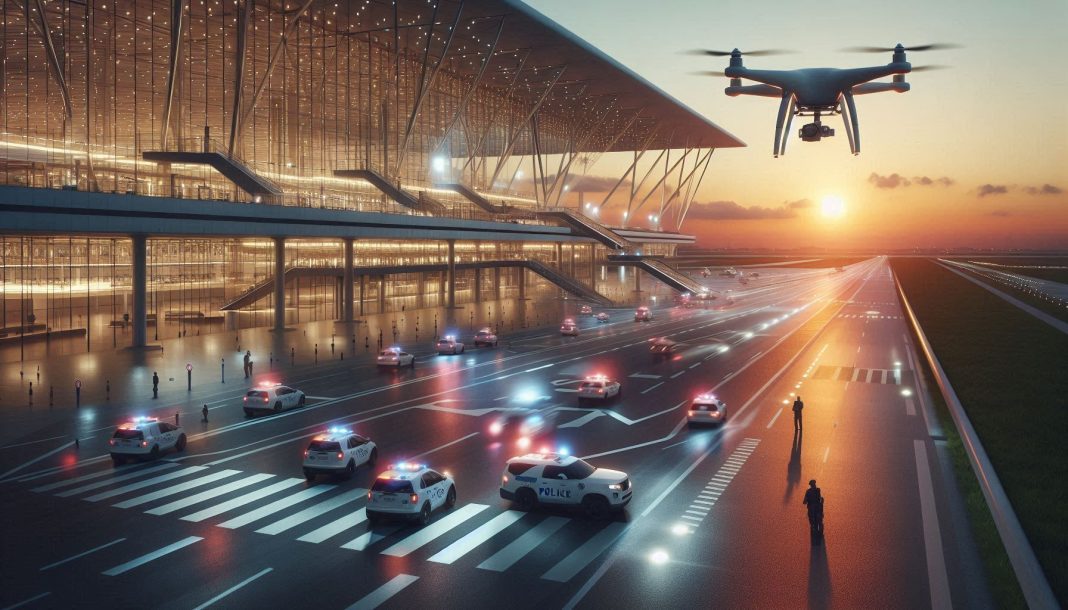On the evening of Monday, September 22, authorities in Denmark detected an unidentified drone flying near Copenhagen, triggering an immediate security response. The drone was seen close to Copenhagen Airport, one of the busiest airports in the country. As a precaution, the airport was closed completely for both take-offs and landings.
Unidentified Drones Force Airport Shutdown in Denmark
Police confirmed that two to three large drones were operating in the vicinity, raising concerns over flight safety. Airport authorities quickly suspended all operations to prevent potential accidents involving commercial flights. According to Flightradar, the suspension began at 20:26 local time. At least 15 flights were diverted to other airports in the region, affecting thousands of passengers and causing significant disruption to air traffic schedules.
Airport officials confirmed that all flight movements were halted, but they did not provide additional details regarding the drones or the ongoing investigation. Police also stated that the time horizon for reopening the airport remained unknown, highlighting the seriousness of the situation. Security personnel closely monitored the area, ensuring the drones did not interfere with aircraft or airport operations.
Denmark steps in with billion-crown lifeline to ease Greenland’s economic and healthcare crisis
The incident demonstrates how vulnerable civil aviation can be to unauthorized drone activity. Airports rely on precise coordination for landings and take-offs, and the presence of uncrewed aerial vehicles in such zones poses serious risks. The swift response by authorities in Copenhagen helped prevent potential accidents while managing the disruption efficiently.
Drone Alarm Triggers Arrests in Norway
Shortly after the event in Denmark, another drone-related incident occurred in Norway.
Around 21:00 local time, authorities raised alarms when they spotted drones above a military area in Oslo, specifically near Akershus fortress. The military detected the drones and immediately responded to safeguard the strategic site.
Authorities detained two individuals from Singapore in connection with the incident. They are investigating why the individuals were near the military zone and why they flew the drones in the area. The arrests highlight the strict security measures authorities enforce to protect sensitive locations from aerial threats.
Trump threatens NATO with ultimatum: no unity, no sanctions on Russia
The Norwegian authorities’ response emphasizes the importance of actively monitoring restricted airspace. Military installations are particularly sensitive areas, and authorities treat any unauthorized aerial activity with utmost seriousness. Their rapid detection and actions in Oslo prevented the drones from threatening military personnel or critical infrastructure.
These incidents in Denmark and Norway show that drone-related disruptions can affect both civilian spaces and military security zones. Both countries acted quickly to contain the situation, demonstrating preparedness and coordination between law enforcement and aviation authorities.
Historical Context: Drone Activity in NATO Regions
The recent drone sightings in Denmark and Norway come amid ongoing concerns about unmanned aerial vehicles crossing national borders in Europe. Earlier in September, during a large-scale attack on Ukraine, Russian drones entered Polish airspace. Poland responded by scrambling fighter aircraft and, for the first time, shooting down hostile drones over its territory.
A similar incident occurred on August 13, when a drone briefly entered Romanian territory and remained airborne for about 50 minutes. These events highlight the challenges countries face in monitoring their airspace and responding to unauthorized drones effectively.
The repeated sightings of drones over European countries underscore the need for heightened security measures and coordination among NATO members. Airspace monitoring systems, early-warning networks, and rapid-reaction teams play a crucial role in detecting and responding to potential aerial threats.
Putin moves Russian jets into Estonian airspace raising NATO concerns over repeated violations
Authorities in both Denmark and Norway are continuing their investigations to determine the origin of the drones and the intentions behind their flights. The focus remains on maintaining public safety, protecting sensitive areas such as airports and military zones, and ensuring that airspace violations are addressed swiftly.
The incidents serve as a reminder of the potential risks posed by drones when they operate without authorization in critical areas. By acting quickly, Denmark and Norway managed to contain the situation while minimizing risks to the public and aviation operations.

